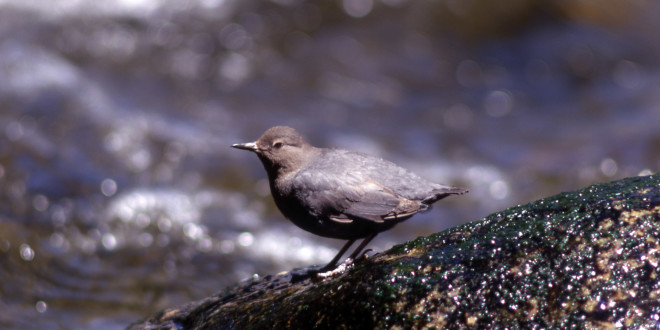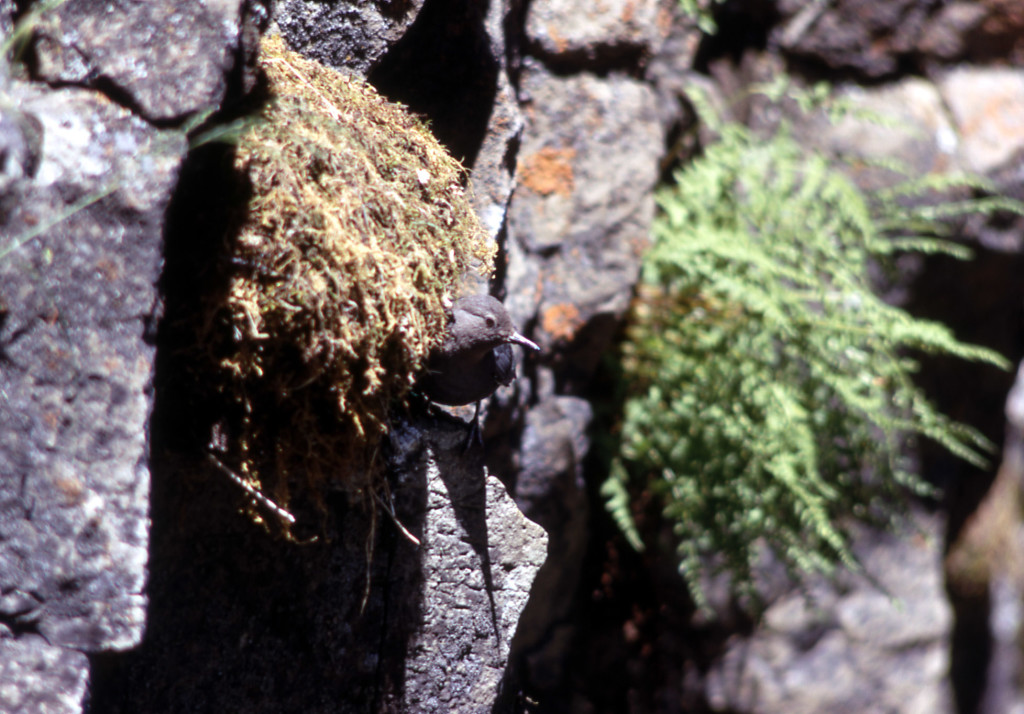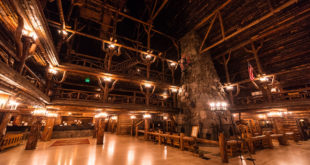The water ouzel, or American dipper, is a familiar sight in Yellowstone National Park streams.
North America’s only aquatic songbird, it divides its time between the trees and the water, swimming along currents (even walking on stream bottoms) to catch insects. The flight and movement of the water ouzel is a unique spectacle.
Indeed, the bird has been delighting visitors for at least a century (likely more). Just read Owen Wister’s rapturous account of watching the bird in the Upper Geyser Basin after a hard day tramping around the Park, post-bath with a blackberry brandy in hand:
Both brandy and bath were a source of rejoicing; and after emerging lean and new from the latter, the spectacle of a little gray bird, like a fat catbird, skimming across the river like a bullet and suddenly dropping below the surface where it was shallow, and walking along the bottom with its tail sticking out in the air, filled me with such elation that I forgot the geysers and watched him. Where it was deeper he would plunge wholly out of sight, run along submerged, reach a shallow place, with his tail again sticking out. Then he would take it into his head to float on top and swim. I came to know him well.
Another famous visitor to Yellowstone, President Theodore Roosevelt, also marveled at the water ouzel, one of many birds he and “Oom John” delighted in seeing and hearing on their 1903 trip to the Park. Indeed, Roosevelt said it was a comparative injustice that the water ouzel isn’t a more noteworthy bird, especially in the older European naturalist tradition:
I cannot understand why the Old World ousel should have received such comparatively scant attention in the books, whether from nature writers or poets; whereas our ousel has greatly impressed all who know him. John Muir’s description [in The Mountains of California] comes nearest to doing him justice. To me he seems a more striking bird than for instance the skylark; though of course I not only admire but am very fond of the skylark … The ousel, on the contrary, is a really brilliant singer, and in his habits he is even farther removed from the commonplace and the uninteresting than the lark himself.
Basic Facts
• Scientific name: Cinclus mexicanus.
• Also called the American Dipper.
• Related to the European Dipper (white-throated dipper), which is Norway’s national bird.
• Only truly aquatic songbird in North America.
• Measure 5.5-7.9 inches long.
• Weigh 1.5-2.4 ounces.
• Live short lives; oldest known was eight years old.
Habitat
• Found mostly in Alaska, British Columbia, western United States, and in parts of Mexico.
• Invariably nest near streams.
• Prefer to nest in cliffs.
• Not known to migrate, but will move in search of unfrozen rivers in winter.
Special Adaptations
• Water ouzels share many adaptations with waterfowl, which let them pursue insects underwater.
• They secrete oil to keep feathers from getting too damp.
• Extra oxygen-carrying capacity in blood.
• Nictitating membrane (semi-transparent eyelid) shields eyes underwater.
• Mold wing and tail feathers in late summer, like ducks.
• Has scales on nostrils to keep them watertight.
• A water ouzel feeds primarily on insect larvae and eggs such as mayflies, mosquitoes, and midges.
• Known to duck heads into water up to 60 times per minute to find prey.
Reproduction
• Build domed, ball-like nests.
• Water ouzels known to dip all nest materials in water prior to construction.
• Lays 4-5 white eggs.
• Eggs incubate 14-17 days.
• Water ouzels stay in the nest for 24-26 days.
• Mainly monogamous.
• The water ouzel generally rears chicks and more often than not part, dividing their territory.
Song
• Water ouzel song is characterized as a “zeet,” with notes repeated or modulated.
• Clear, ringing sound.
 Yellowstone Insider Your Complete Guide to America's First National Park
Yellowstone Insider Your Complete Guide to America's First National Park







You must be logged in to post a comment.